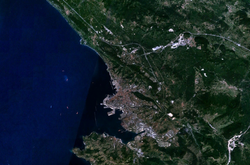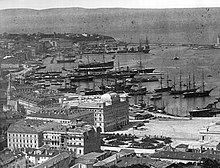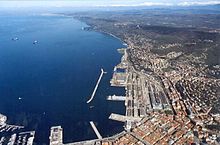Trieste port
| Trieste port | |
|---|---|
| founding year | 1719 |
| Type port | seaport |
| place | Trieste |
| sales | approx. 56,600 NRT - general cargo: 13.05 million t (2004) - mineral oil: 35.95 million t (2004) |
| Overseas connections |
To overview |
| Harbor area | 2,304,000 m² |
| Free port | 1,765,000 m² |
| storage area | 925,000 m² |
| Quay length | 12,128 m |
| Max. Draft | 18 m |
| Latitude | 45 ° 39 ′ N. |
| Longitude | 13 ° 47 ′ E |
| operator | Port Authority of Trieste (Autorità Portuale Trieste) |
| president | Zeno D'Agostino |
| Postal address |
3 Via von Bruck 34143 Trieste, Italy |
| Homepage | http://www.porto.trieste.it/ |
The port of Trieste ( Italian Porto di Trieste ) is a free port and largest seaport in the Upper Adriatic Sea . The deep-water port is considered to be the maritime gateway for northern Italy, Germany, Austria and Central Europe and the end point of the maritime Silk Road ( Maritim Silk Road or 21st Century Maritim Silk Road ) with its connections via the Suez Canal or Turkey to China, Japan and many countries in Asia. The port of Trieste is a logistics hub and is linked via the Baltic-Adriatic axis to the Baltic Sea region and Scandinavia .
The port is part of the north-eastern Italian border town of Trieste , in the immediate vicinity of Slovenia and the Koper port located there .
Port structure and use
The port of Trieste is divided into five free zones, three of which are privately operated:
- Old Free Port ( Punto Franco Vecchio )
- New free port ( Punto Franco Nuovo )
- Timber Terminal ( Scalo Legnami )
The remaining two are managed directly by the port authority and both are used industrially:
- Mineral oil free zone ( Punto Franco olii minerali )
- "Zaulkanal" free zone ( Punto Franco del canale di Zaule )
The entire port area has an area of 2,304,000 square meters, 1,765,000 square meters of which are designated as the free port zone. 925,000 square meters of storage space are available, 500,000 square meters of which are closed and covered. The free port zone is a foreign customs country of the European Union .
The port of Trieste has 12 quays and 47 operational berths . A rail network in the port consists of 75 kilometers of tracks, with direct rail connections for all quays.
history
In the 19th century, shipping companies and shipyards were founded in the up-and-coming Trieste in addition to insurance companies and bank branches. These included the Österreichischer Lloyd (1833), the “San Marco” shipyard (1839/1840), the Giuseppe Tonellos shipyard (1852) and the Lloyd-Arsenal in 1860, as the private shipyards could no longer keep up with the production for the fast-growing shipping company .
Since June 16, 1930, all Trieste shipyards (with the exception of the Lloyd area) have formed the Cantieri Riuniti dell 'Adriatico company .
Free port
The importance of the port of Trieste as a seaport and transshipment point, as well as a trade and economic center grew from the 18th century with the establishment of the free port by Emperor Charles VI. of Austria in 1719. With Austrian support, Trieste replaced Venice in its leading role in trade with the Middle East and developed into the largest trading center on the Adriatic. In 1802 5442 ships called at the port of Trieste, handling 483,326 tons of goods. At the height of Trieste's heyday, around 100 years later, there were more than twice as many ships and more than ten times as much cargo handling. The main commodities were coffee, sugar and tropical fruits as well as wines, oils, cotton, iron, wood and machines.
The opening of the Suez Canal in 1869 reinforced the function of the port of Trieste as access to the Central European economic centers, along the trade routes to the Middle and Far East . Austrian industrial products were now also sold in Turkey , Egypt and Syria . From 1867 the old port facilities, which no longer corresponded to the growing trade, were expanded. First the northern free port ( punto franco ) was expanded. In 1880 the volume of cargo handled in the Trieste ports was 1.225 million tons. By 1912 this amount rose to 4.573 million t. In 1883, the 30 million kronor port renovation in the south of the city was completed. The storage areas as well as the new south station ( stazione meridionale ), which still exists today as the only passenger station in the city, were largely built on heaped land. The most important train station until 1918 was the state train station (stazione della stato). The new port ( porto nuovo ), which was expanded from 1898 and was called Josephs-Hafen until the end of the monarchy, stretched between it and the Lloyd area . The largest shipping company in Austria-Hungary at the time was Österreichischer Lloyd , which was also one of the largest shipping companies in the world and was based in Trieste.
Old Port
Along with the facilities in Buenos Aires , Calcutta and Hamburg, Trieste was one of the first ports in the world to be equipped with a hydrodynamic system. The building for this is located behind the main pier and is marked by two towers on the main facade. The system supplied various quay cranes as well as cranes and lifting systems for the storage buildings with electricity. It has not been operated since 1983. The facility and the building are exemplary of the imperial and royal industrial architecture of that time and industrial monuments for the port's past.
The area of the old port is of great urban significance for Trieste and offers the city the possibility of a cultural and commercial reuse in the maritime spirit of the city.
Modern port extensions
Since the beginning of the 1970s, the port authority has been developing a new so-called southern port. The port of Trieste wants to expand the range of uses of the port through a better upstream infrastructure of roads and rails: Trieste is currently expanding the entire Scalo Legnami port terminal by 70 million square meters with an investment volume of 50 million euros with the aim of strengthening the competitiveness of the port. In order to improve the rail connections, the road network and the port's logistical platform, the Italian government is funding the project with 560 million euros.
Location and connection
traffic
The port of Trieste is one of the largest Italian ports and, due to its special location, also one of the most important trading ports for Austria , southern Bavaria , the Czech Republic and Slovakia . For some years now, however, Austria’s foreign trade has been handled more intensively via the port of Koper , which is in a position to compete in its location . Slovenia's overseas trade is also largely carried out via the port of Koper; trade between Croatia and Hungary via the port of Rijeka .
In 2016, the cargo handling in the port amounted to a volume of 59 million tons, of which 43 million tons were liquid goods such as crude oil , which is forwarded via the SIOT terminal (via the Transalpine Oil Pipeline in the direction of Austria / Schwechat and Germany / Ingolstadt , with a junction to the Czech Republic ). The remaining cargo volume consists of solid bulk goods (2 million t) such as coal , wood , minerals , grain and oil seeds . The handling of containers is not that important at 486,507 TEU (2016).
The port of Trieste is also a major ferry and cruise port, with several routes serving the port.
Shipyards
- Fincantieri
- Officina Navale Quaiat
- Fassmer GmbH
- San Marco shipyard, 1839/1840 (historical)
- San Rocco shipyard (historic)
- Giuseppe Tonello shipyard, 1852 (historical)
- Lloyd- Area, 1860 (historical)
Shipping companies
- Adria Maritime
- Austro-Americana (historical)
- CMA-CGM
- Costa cruises (cruises)
- Cosco Hong Kong Group
- Evergreen Marine Corporation
- Hapag-Lloyd Kreuzfahrten (cruises)
- Italia Marittima (until 2006: Lloyd Triestino , previously Austrian Lloyd )
- Maersk Line
- MSC - Mediterranean Shipping Company
- Zim Integrated Shipping Services
Port and shipping companies
- Association of Freight Forwarders of the Port of Trieste
- Italian Association of Shipowners of Shipping Lines
- Italian Association of Free Shipowners
- Compagnia Lavoratori Portuali Di Trieste
- Trieste Pilots Body
- Working group Alps-Adriatic
See also
- Austrian Navy
- Faro della Vittoria , Victory Lighthouse (1927)
- Lanterna , former lighthouse in Porto Vecchio (1831/32)
- Molo Audace , quay in Porto Vecchio
- Molo Sartorio , harbor quay and historical place for measuring the sea level
literature
- Heinrich von Costa: The free port of Trieste, Austria's main staging area for overseas world trade . PP Mechitaristen-Congregations-Buchdruckerei, Vienna 1838 ( digitized version )
Web links
- Official website of the Port Authority of Trieste
- The port of Trieste (inforMare.it)
- Trieste tour: the "New Harbor" built in 1867-83
- Texts on the stagnation of the port of Trieste (ca. 1815-ca. 1918)
- FX v.Neumann-Spallart: The tasks of the port of Trieste for Austria and Germany (contemporary document 1882)
Individual evidence
- ↑ Austria's ports to the wide world ( page no longer available , search in web archives ) Info: The link was automatically marked as defective. Please check the link according to the instructions and then remove this notice. , In: Logistik express, issue 3/2010, accessed on July 24, 2013
- ↑ Wolfhart Fabarius: Trieste handles fewer boxes . In: Daily port report from February 1, 2017, p. 4





